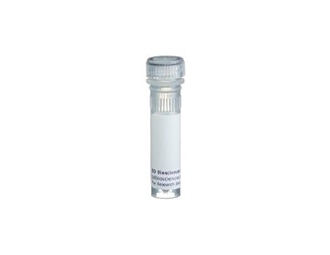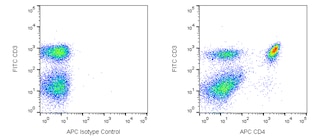Old Browser
Looks like you're visiting us from {countryName}.
Would you like to stay on the current country site or be switched to your country?




Detection of CXCR4 expression on BALB/c thymocytes by biotinylated 2B11/CXCR4. BALB/c thymocytes were stained with 0.25 µg/test of biotinylated 2B11/CXCR4 followed by Streptavidin-PE (Cat. No. 554061) and anti-mouse CD4-APC (Cat. No. 553051). The data reflects gating on lymphocytes, based on forward and side scattered light signals. The level of nonspecific staining was assessed by using biotinylated rat IgG2b (Cat. No. 553987) as isotype control. The quadrant markers for the bivariate dot plots were set based on the isotype control.


BD Pharmingen™ Biotin Rat Anti-Mouse CD184

监管状态图例
未经BD明确书面授权,严禁使用未经许可的任何商品。
准备和存储
商品通知
- Since applications vary, each investigator should titrate the reagent to obtain optimal results.
- Please refer to www.bdbiosciences.com/us/s/resources for technical protocols.
- Caution: Sodium azide yields highly toxic hydrazoic acid under acidic conditions. Dilute azide compounds in running water before discarding to avoid accumulation of potentially explosive deposits in plumbing.
配套商品


The 2B11/CXCR4 monoclonal antibody specifically binds to mouse CD184, which is also known as the C-X-C Chemokine Receptor type 4 , CXCR4. CXCR4 (previously known as Fusin and LESTR), is a seven-transmembrane, G-protein-coupled receptor. It is the specific receptor for the CXC chemokine, SDF-1/CXCL12. Mouse CXCR4 shows 91% homology at the amino acid level with human CXCR4. CXCR4 is widely expressed by hematopoietic and non-hematopoietic cell types including neutrophils, monocytes, T cells, B cells, CD34-positive progenitor cells, endothelial cells, neurons and astrocytes. Human CXCR4 is used by T-tropic HIV-1 as a co-receptor for viral entry. The mouse Cxcr4 gene has been mapped to chromosome 1.
This antibody is routinely tested by flow cytometric analysis. Other applications were tested at BD Biosciences Pharmingen during antibody development only or reported in the literature.
研发参考 (10)
-
Bleul CC, Farzan M, Choe H, et al. The lymphocyte chemoattractant SDF-1 is a ligand for LESTR/fusin and blocks HIV-1 entry. Nature. 1996; 382(6594):829-833. (Biology). 查看参考
-
Bleul CC, Wu L, Hoxie JA, Springer TA, Mackay CR. The HIV coreceptors CXCR4 and CCR5 are differentially expressed and regulated on human T lymphocytes.. Proc Natl Acad Sci U S A. 1997; 94(5):1925-1930. (Biology). 查看参考
-
Feng Y, Broder CC, Kennedy PE, Berger EA. HIV-1 entry cofactor: functional cDNA cloning of a seven-transmembrane, G protein-coupled receptor. Science. 1996; 272(5263):872-877. (Biology). 查看参考
-
Forster R, Kremmer E, Schubel A, et al. Intracellular and surface expression of the HIV-1 coreceptor CXCR4/fusin on various leukocyte subsets: rapid internalization and recycling upon activation. J Immunol. 1998; 160(3):1522-1531. (Immunogen). 查看参考
-
Gupta SK, Lysko PG, Pillarisetti K, Ohlstein E, Stadel JM. Chemokine receptors in human endothelial cells. Functional expression of CXCR4 and its transcriptional regulation by inflammatory cytokines. J Biol Chem. 1998; 273(7):4282-4287. (Biology). 查看参考
-
Heesen M, Berman MA, Benson JD, Gerard C, Dorf ME. Cloning of the mouse fusin gene, homologue to a human HIV-1 co-factor. J Immunol. 1996; 157(12):5455-5460. (Biology). 查看参考
-
Hesselgesser J, Halks-Miller M, DelVecchio V, et al. CD4-independent association between HIV-1 gp120 and CXCR4: functional chemokine receptors are expressed in human neurons. Curr Biol. 1997; 7(2):112-121. (Biology). 查看参考
-
Loetscher M, Geiser T, O'Reilly T, Zwahlen R, Baggiolini M, Moser B. Cloning of a human seven-transmembrane domain receptor, LESTR, that is highly expressed in leukocytes. J Biol Chem. 1994; 269(1):232-237. (Biology). 查看参考
-
Oberlin E, Amara A, Bachelerie F, et al. The CXC chemokine SDF-1 is the ligand for LESTR/fusin and prevents infection by T-cell-line-adapted HIV-1. Nature. 1996; 382(6594):833-835. (Biology). 查看参考
-
Schabath R, Muller G, Schubel A, Kremmer E, Lipp M, Forster R. The murine chemokine receptor CXCR4 is tightly regulated during T cell development and activation. J Leukoc Biol. 1999; 66(6):996-1004. (Biology). 查看参考
Please refer to Support Documents for Quality Certificates
Global - Refer to manufacturer's instructions for use and related User Manuals and Technical data sheets before using this products as described
Comparisons, where applicable, are made against older BD Technology, manual methods or are general performance claims. Comparisons are not made against non-BD technologies, unless otherwise noted.
For Research Use Only. Not for use in diagnostic or therapeutic procedures.
Report a Site Issue
This form is intended to help us improve our website experience. For other support, please visit our Contact Us page.